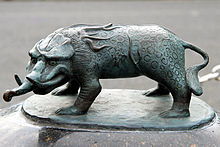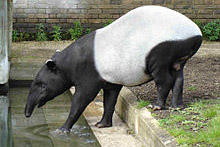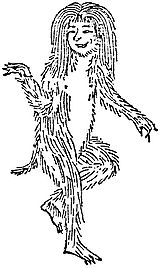From monsters to animalsOctober 10, 2013 |
Home > Blog > Post 5< Previous Next > |
Animals not found in Japan or China seldom have kanji in their names. Most often, their names are katakana transcriptions:
Skunk: スカンク [sukanku]Opossum: オポッサム [opossamu]
Kangaroo: カンガルー [kangaru:]
Kanji come out when, for example, a Western name is translated word by word:
Anteater: 蟻食い [arikui] (蟻 ‘ant’ + 食 ‘eat’)Platypus, duckbill: 鴨嘴 [kamonohashi] (鴨 ‘duck’ + 嘴 ‘bill’)
There are also several made-up words, without exact prototypes in other languages:
Zebra: 縞馬 [shimauma] (縞 ‘stripe’ + 馬 ‘horse’)Racoon: 洗熊 [araiguma] (洗 ‘wash’ + 熊 ‘bear’)
But today we talk about the few miraculous cases when a newly discovered animal adopts a name of a mythical creature!
Here are three examples.
麒麟 KIRIN
Most of us have seen Chinese monsters called Qilin on cans of Japanese “Kirin” beer. They are usually depicted with dragon’s head, tiger’s body, scales and hooves. Nobody had ever met them until early 15th century when Zheng He, the famous admiral and explorer, brought two live giraffes from Africa and presented them to the Yongle emperor as “qilins”. The emperor was flattered to have magical creatures under his power. Eventually, quilins and giraffes were considered to be the same creature and identified as such in Korea and Japan. In modern Japanese, only the way of writing helps to differentiate between mythology and zoology: 麒麟 usually means the mythical Qilin, while キリン or きりん signify the real African animal.
 |  |
貘 BAKU
This monster is rather Japanese than Chinese. Its main feature is the ability to eat people’s dreams and nightmares. Baku was traditionally depicted with a trunk, somewhat shorter than that of an elephant, so when the Japanese (or, maybe, Chinese) fist met a Malayan tapir, there was no hesitation about how to name this new beast. The two bakus, mythological and zoological, intertwined so closely that eventually Baku the monster acquired all the features of Baku the animal. In modern manga and anime, you can come across a character that eats dreams like a Baku but looks just like a tapir! Unlike the qilin-giraffe, the kanji for Baku is used in both ways: 貘 can either mean the animal or the monster, depending on the context.
 |  |
猩々 SHO:JO:
Yet another Japanese monster with Chinese roots. A red-faced hairy creature, fond of alcohol. If you meet a Shojo on a mountain slope or sea bank, he will always offer you a ladleful of sake. In Japanese, the word 猩々 can also mean “heavy drinker”. Obviously, orangutans from Indonesian islands resembled these monsters so closely that immediately were dubbed 猩々. This name ("shēng shēng") is still used in Chinese for orangutans and not only for them: a gorilla is called 大猩々 (“big shēng shēng”), and a chimpanzee 黒猩々 (“black shēng shēng”). In Japanese, however, these words are all obsolete now; apes are usually referred to as オランウータン, ゴリラ and チンパンジー.
 |  |
When I try to find this model in other languages, I find the only example in my native Russian where a hippopotamus is called “behemoth”,
after the Biblical beast that God showed to Job as a proof of his power. Can you think of any other examples?
Vadim Smolensky